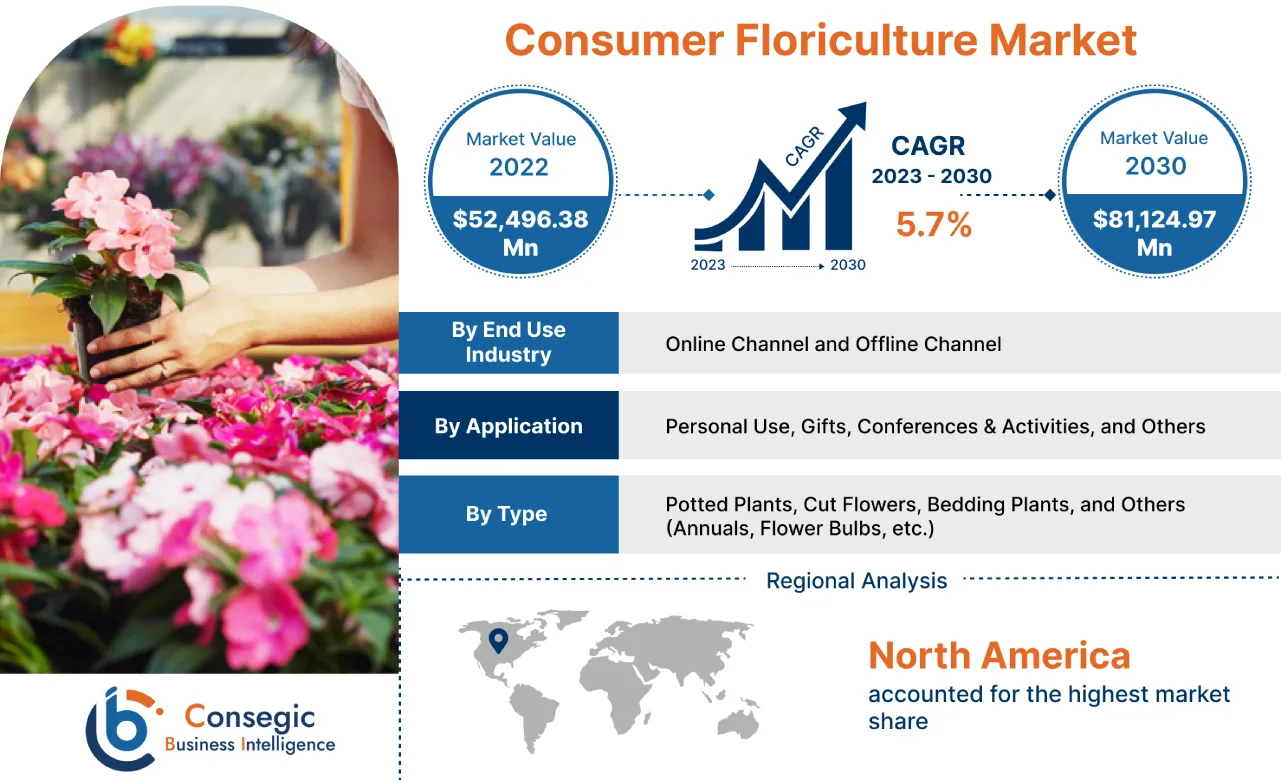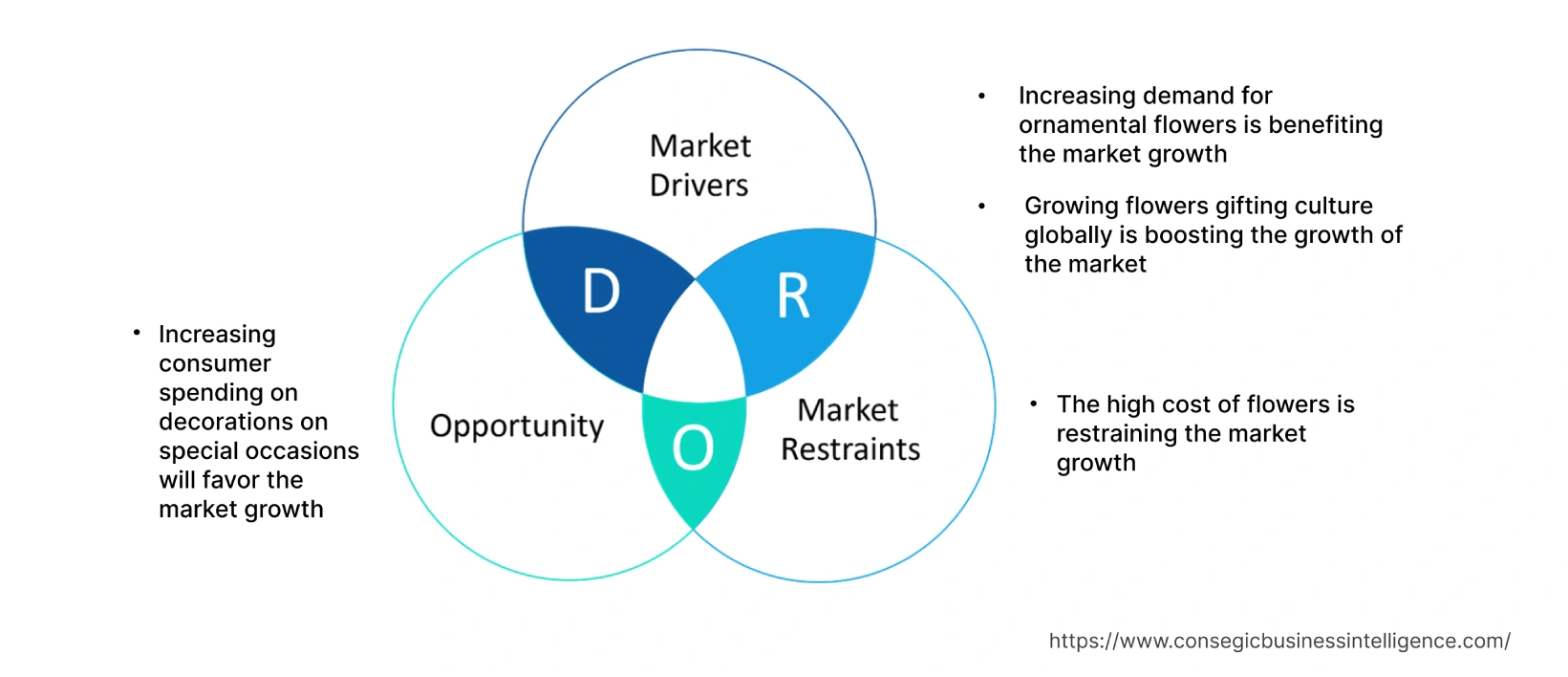- Summary
- Table Of Content
- Methodology
Consumer Floriculture Market Introduction :
Consegic Business Intelligence analyzes that the Global Consumer Floriculture Market size is growing with a healthy CAGR of 5.7% during the forecast period (2023-2030), and the market is projected to be valued at USD 81,124.97 Million by 2030 from USD 52,496.38 Million in 2022.
Consumer Floriculture Market Definition & Overview :
Consumer floriculture is the sector of the floriculture industry that focuses on the production and sale of flowering plants for personal and commercial use. This includes a wide variety of products, such as cut flowers, bedding plants, potted plants, and flowering bulbs. Consumer floriculture involves various commercial activities such as flower trading, supplying, saplings, greens, and ornamental plants, landscaping in real estate, floral designing and custom-made products for weddings and festivities, extracting essential oils, and preparing ingredients in the pharmaceutical sector. Consumer floriculture is one of the booming industries across the globe. Furthermore, the consumer floriculture industry has a prominent potential of generating employment as well as high income. This, in turn, is driving the market for consumer floriculture.
Consumer Floriculture Market Insights :
Key Drivers :
Increasing demand for ornamental flowers
Ornamental plants are used for landscaping, adding aesthetic features with flowers, gifting, and other applications. These ornamental flowers are highly preferred for gifting, decorations, and personal uses. The high demand for ornamental flowers is increasing the production of these flowers across floriculture farms. For instance, according to the data published by Turkish Statistical Institute in December 2022, the production of ornamental plants across Turkey in 2022 increased by 20.4% in 2022 as compared with the previous year 2021. Analysis of market trends concludes that the increasing exports of ornamental flowers are also boosting the market expansion. Hence, the significant increase in the production and exports of ornamental flowers is driving the consumer floriculture market demand.
Growing flowers gifting culture globally
Flowers are the preferred choice for expressing feelings on special occasions. The emotional value associated with the flowers makes them a preferred choice for gifting. This flower gifting culture is also incorporated across the business and corporate offices to greet, appreciate and celebrate achievements for employees, clients, and colleagues. For instance, according to research published by the Society of American Florists in February 2022, 88% of Americans said that giving flowers makes them happy, while 80% say that receiving flowers makes them feel the same way. Analysis of market trends concludes that the high social acceptance of flowers as a gifting option and growing preference for flower gifting is improving the demand for floral products. This, in turn, is driving the growth of the market.
Key Restraints :
The high cost of flowers
Floriculture involves the cultivation, management, and distribution of ornamental, flowing, and foliage plants. Several factors affect the end price of consumer floriculture, such as high production costs, maintenance costs, labor costs, transportation costs, and others. Climate change could be a major factor affecting the production of flowers. For instance, unpredictable weather patterns, extreme heat, irregular precipitation, rains, drought, heat waves, etc. are the events that lead to the disruption in the cultivation patterns, destroying the whole production and affecting the end price of the flowers. Furthermore, there is a growing influence of artificial flowers owing to their benefits such as lower cost and reusability. Analysis of market trends concludes that the high cost of flowers and availability of artificial flowers are posing a major roadblock to the revenue growth of the market.
Future Opportunities :
Increasing consumer spending on decorations on special occasions
Flowers are preferred for decorations at various occasions such as Christmas, birthday parties, anniversaries, and other events. The increasing consumer spending on flower decorations is expected to provide lucrative growth opportunities for the global consumer floriculture market. For instance, according to the data published by the Society of American Florists in February 2022, the annual spending on cut flowers in the U.S. accounted for USD 1.83 billion, making U.S. the largest consumer of cut flowers, followed by the U.K. and Russia. Analysis of market trends concludes that the increasing consumer spending on flowers for decorations and other applications across the globe is emerging as one of many consumer floriculture market opportunities that will drive market expansion. This prominent factor is supplementing the Consumer Floriculture market.
Consumer Floriculture Market Report Insights :
| Report Attributes | Report Details |
| Study Timeline | 2017-2030 |
| Market Size in 2030 | USD 81,124.97 Million |
| CAGR (2023-2030) | 5.7% |
| By Type | Potted Plants, Cut Flowers, Bedding Plants, and Others (Annuals, Flower Bulbs, etc.) |
| By Application | Personal Use, Gifts, Conferences & Activities, and Others |
| By End-use Industry | Online Channel and Offline Channel |
| By Region | North America, Europe, Asia-Pacific, Latin America, and Middle East & Africa |
| Key Players | Dazinger Group, Dummen Orange, Karen Roses, Kurt Weiss Greenhouses Inc., Marginpar BV, Multiflora Ltd., Ruparelia Ltd., Selecta Group, Syngenta, and Rosebud Ltd. |
Consumer Floriculture Market Segmental Analysis :
Based on the Type :
The type segment is categorized into potted plants, cut flowers, bedding plants, and others (annuals, flower bulbs, etc.). In 2022, the cut flowers segment accounted for the highest market share of 43.50% in the overall consumer floriculture market. Cut flowers are ornamental or flower-bearing flowers that are cut from the stem of the bearing plant. Cut flowers are mostly used for decorative uses. These types of plants are cultivated under greenhouses as well as can be harvested from wild locations. Cut flowers are used for floral arrangements and decoration purposes in residential and commercial locations. Analysis of market trends concludes that the increasing exports of cut flowers worldwide are driving segment growth. For instance, according to the data published by Observatory for Economic Complexity, the export of cut flowers in 2021 accounted for USD 10.5 billion which was USD 8.47 billion in 2020. Thus, due to the above-mentioned factors, the market for cut flowers is increasing globally, which, in turn, is benefiting the market proliferation.
However, the bedding plants segment is expected to be the fastest-growing segment during the forecast period. This is due to the increasing adoption of bedding plants for landscaping. Bedding plants possess bright colors and diverse textures and thus are being increasingly used in decoration of patios and house gardens. They are being extensively utilized as they are a low maintenance alternative that require relatively minimal care, thus being an excellent choice for individuals that are new to the hobby of floriculture. Their widespread availability at most plant nurseries and garden centers leads makes bedding plants the convenient choice for purchase, thus facilitating growth of the segment. Moreover, various factors regarding the characteristics of bedding such as instant curb appeal and versatility in design are leading to their increased sales, therefore causing expansion of the market.
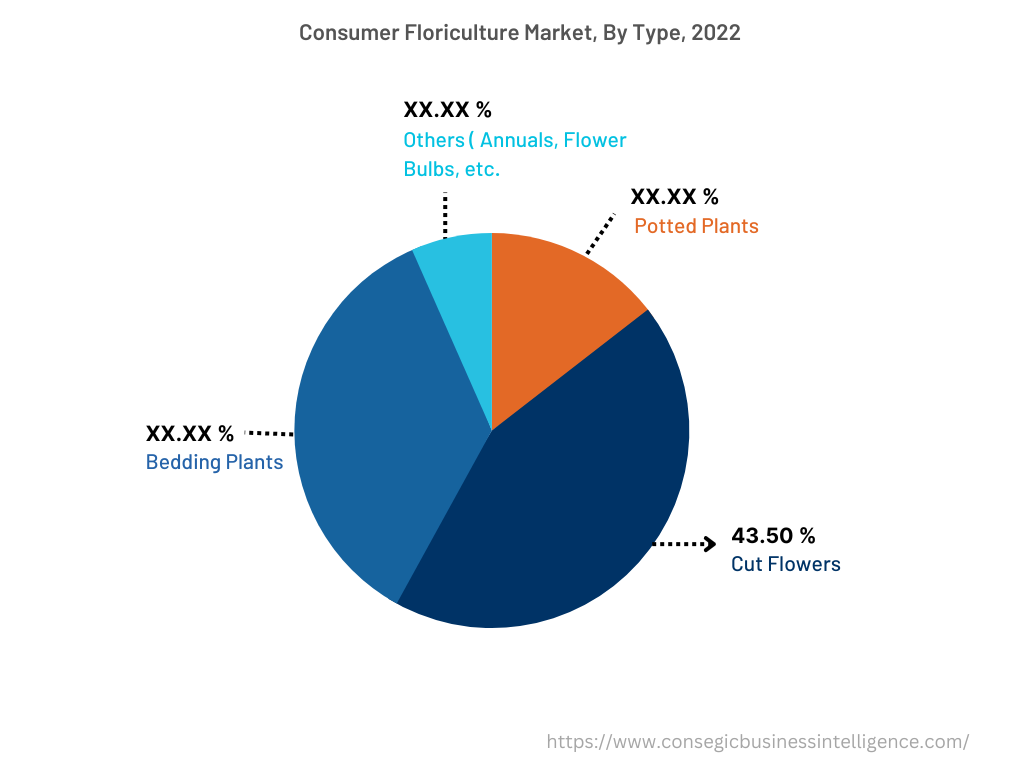
Based on the Application :
The application segment is categorized into personal use, gift, conferences & activities, and others. In 2022, the conferences & activities segment accounted for the highest consumer floriculture market share. Flowers are used for various occasions and activities. Ornamental flowers such as delphiniums, orchids, tulips, roses, and daffodils are used for conferences and corporate events to create a pleasing environment for the attendees. For instance, corporate events such as internal business meetings, large conferences product launches, and special occasions in offices use flowers for decorating office spaces. Analysis of market trends concludes that the increasing demand for flowers from the conferences & activities will boost the sale of flowers for conferences & activities in the upcoming years.
However, the gifts segment is expected to be the fastest-growing segment during the forecast period because of the growing flower gifting culture, and others. The emergence of online platforms has enabled individuals to purchase gifts made with flowers easily and have them delivered at any desired location as per user needs. Moreover, the oncoming shift in sustainable corporate gifting culture is boosting the expansion of the market as gifts with flowers are perceived to be an environmentally conscious choice that can also be personalized as per buyer needs.
Based on the Distribution Channel :
The distribution channel segment is categorized into online channels and offline channels. In 2022, the offline channel segment accounted for the highest market share in the consumer floriculture market. The offline distribution of flowers includes sales channels such as retail stores, flower vendors, floral shops, and others. These sales channels mostly have direct interaction with consumers, due to which consumers can ensure the availability of particular flowers, their freshness, customization options, etc. Moreover, according to a report by The International Association of Horticultural Producers in May 2021, the offline sale of flowers across the globe accounts for 70% of the total sale of flowers. Hence, the high sales of flowers through offline distribution channels will boost segment growth in the upcoming years.
However, the online channel segment is expected to be the fastest-growing segment during the forecast period because of the growing prevalence of online shopping and increasing online flower distribution platforms worldwide. Buyers utilize online sales platform as it facilitates effortless shopping. Buyers can easily browse through a huge selection of flowers and floral arrangements from anywhere. The ability of online platforms to deliver products to buyer's doorstep in few hours of placing the order is boosting the market expansion.
Based on the Region :
The regional segment includes North America, Europe, Asia Pacific, the Middle East and Africa, and Latin America.
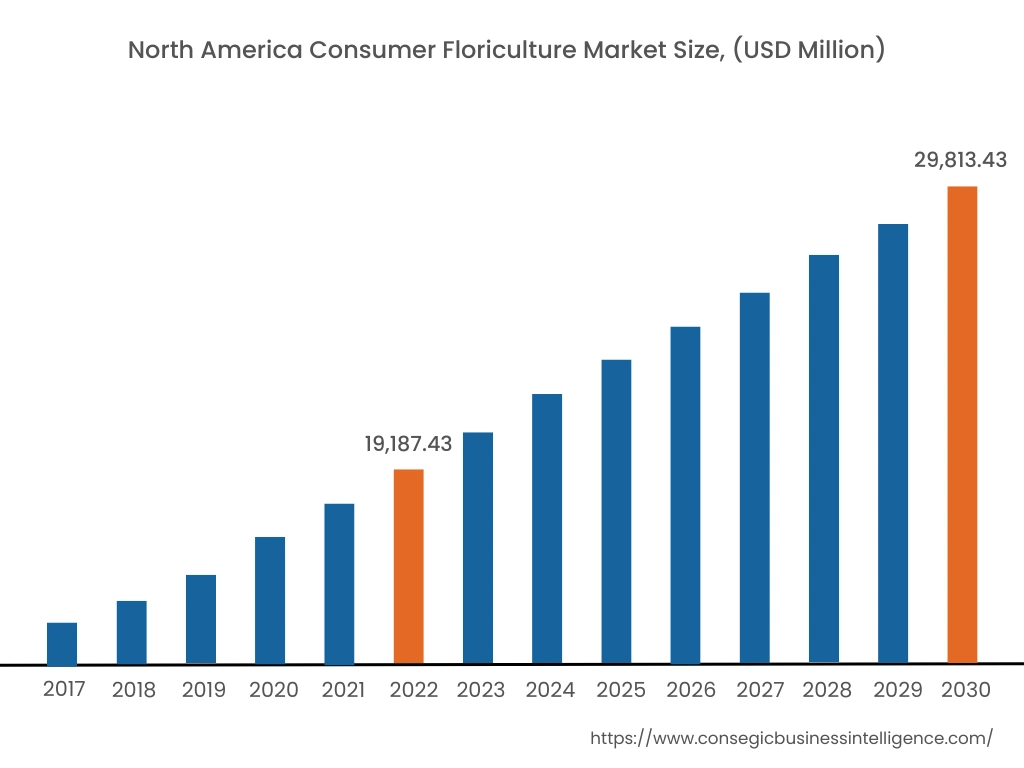
In 2022, North America accounted for the highest market share at 36.55% and was valued at USD 19,187.43 million, and is expected to reach USD 29,813.43 million in 2030. Analysis of consumer floriculture market trends indicates that in North America, the U.S. accounted for the highest market share of 71.55% during the base year of 2022. This is due to the growing consumer trend of buying flowers, increasing consumer spending on flowers and potted plants, and others. For instance, according to the research report by the Society of American Florists in February 2022, 60% of Americans believe a gift of flowers has a special meaning, unlike any other gift. Furthermore, according to the U.S. Bureau of Economic Analysis, the per capita spending on flowers and potted plants in the U.S. in 2020 accounted for USD 140.93 billion which increased to USD 170.88 billion in 2021. Henceforth, the increase in the demand for flowers in the North American region is proliferating the consumer floriculture market growth.
Furthermore, Asia Pacific is expected to witness significant growth over the forecast period, growing at a CAGR of 6.5% during 2023-2030. This is due to the increasing floriculture projects in the region.
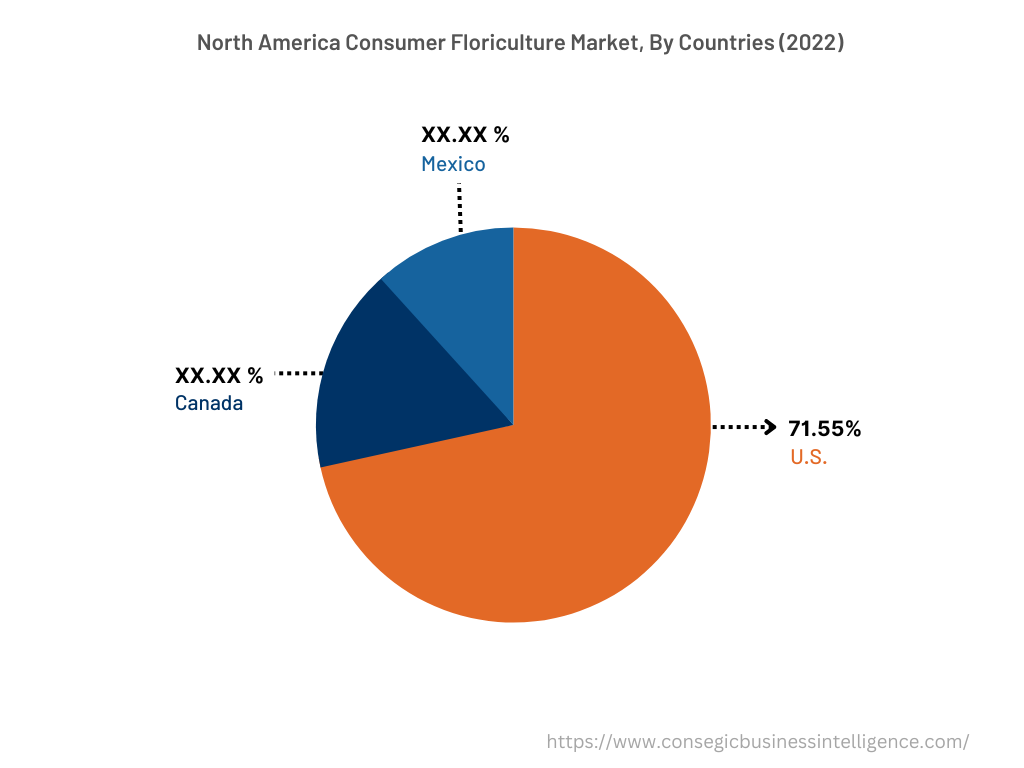
Top Key Players & Market Share Insights :
The Consumer Floriculture market is highly competitive, with several large players and numerous small and medium-sized enterprises. The major companies operating in the consumer floriculture industry have strong research and development capabilities and a strong presence in the market through their extensive product portfolios and distribution networks. The consumer floriculture market analysis concluded that the market is characterized by intense competition, with companies focusing on expanding their product offerings and increasing their market share through mergers, acquisitions, and partnerships. The key players in the market include-
- Dazinger Group
- Dummen Orange
- Selecta Group
- Syngenta
- Rosebud Ltd.
- Karen Roses
- Kurt Weiss Greenhouses Inc.
- Marginpar BV
- Multiflora Ltd.
- Ruparelia Ltd.
Recent Industry Developments :
- In July 2021, Colvin, a technology-based company announced that they have raised USD 53.1 million from Eurazeo with participation from agrifood-focused VC Capagro, both of which are based in Paris. With this investment, the startup aims to expand its B2C presence across Europe.
Key Questions Answered in the Report
What was the market size of the consumer floriculture industry in 2022? +
In 2022, the market size of consumer floriculture was USD 52,496.38 million
What will be the potential market valuation for the Consumer Floriculture industry by 2030? +
In 2030, the market size of consumer floriculture will be expected to reach USD 81,124.97 million.
What are the key factors driving the growth of the consumer floriculture market? +
Increasing the production of ornamental flowers is benefiting the market growth.
What is the dominating segment in the consumer floriculture market by type? +
In 2022, the cut flower segment accounted for the highest market share of 43.50% in the overall consumer floriculture market.
Based on current market trends and future predictions, which geographical region is the dominating region in the Consumer Floriculture market? +
North America accounted for the highest market share in the overall Consumer Floriculture market.
